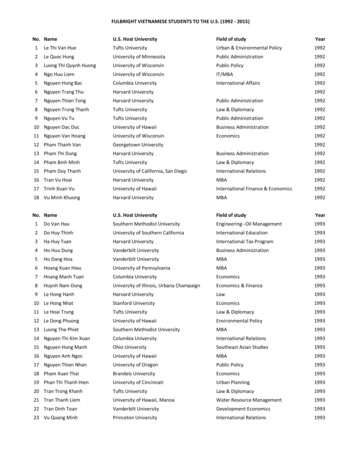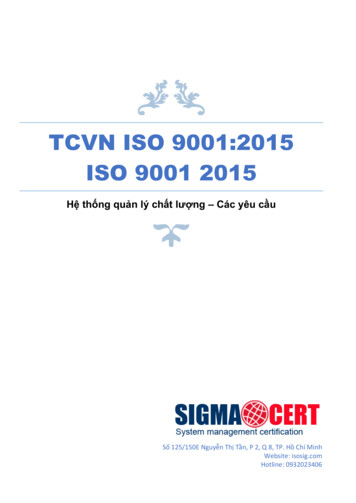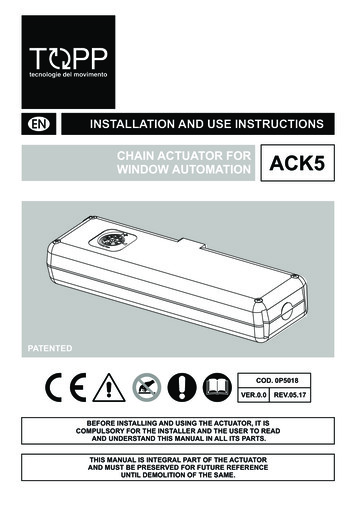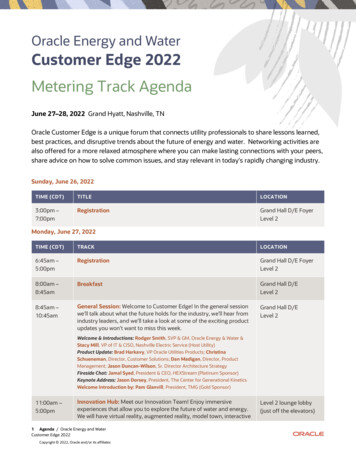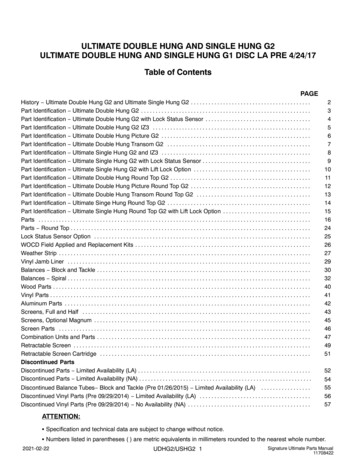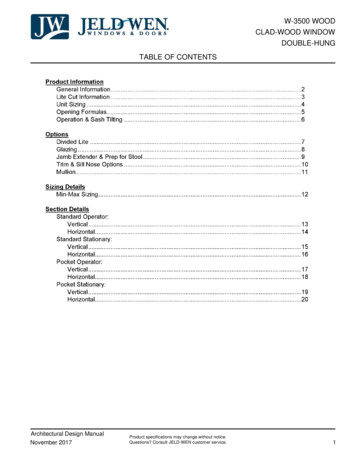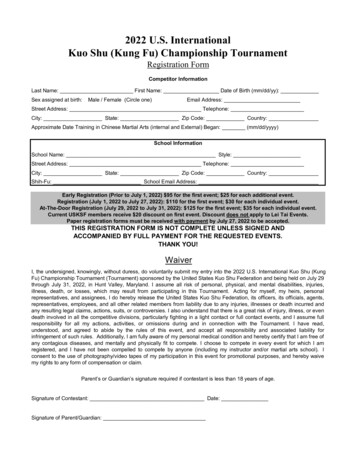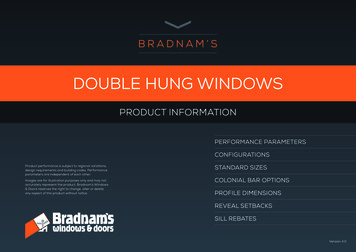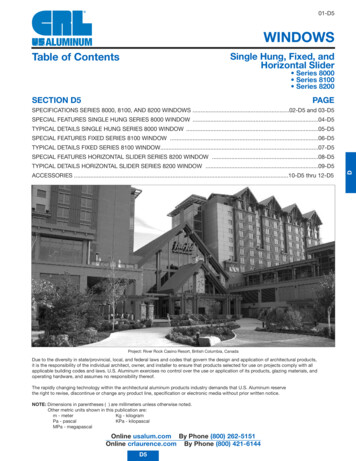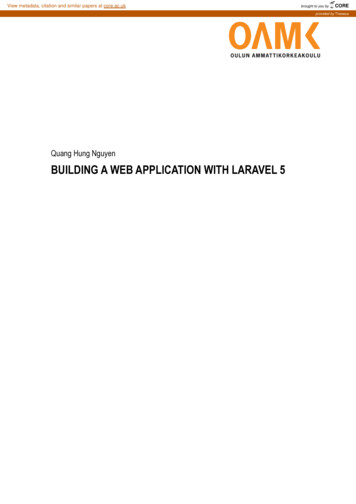
Transcription
View metadata, citation and similar papers at core.ac.ukbrought to you byCOREprovided by TheseusQuang Hung NguyenBUILDING A WEB APPLICATION WITH LARAVEL 5
BUILDING A WEB APPLICATION WITH LARAVEL 5Quang Hung NguyenBachelor thesisAutumn 2015Business Information TechnologyOulu University of Applied Sciences
CONTENTS1INTRODUCTION . 42LARAVEL. 6342.1Structure of a Laravel 5 application . 72.2Model-View-Controller and Middleware . 82.3Contracts and Repository pattern . 102.4Blade template . 142.5Package manager: Composer . 152.6Artisan. 162.7Setup working environment and workflow . 16BUILDING APPLICATION WITH LARAVEL. 183.1The movie review application . 183.2Creating and configuring new application . 203.3Migration files and Eloquent models creation . 213.4Middleware and controller. 24CONCLUSION . 30REFERENCES . 31APPENDICES . 333
1IntroductionIn modern IT industry, it is essential for web developers to know at least one battle-proven framework.Laravel is one of the most successful PHP framework in 2015, based on annual framework popularitysurvey conducted by SitePoint (SitePoint, The Best PHP Framework for 2015: SitePoint Survey Results,cited, 25.10.2015).There are several advantages and benefits of using web framework in general and Laravel in particular.Framework is a product of collective intelligence, comprising many robust libraries and convenient toolsfrom other developers. They help to reduce most of the repetitive tasks and complex tasks in simpleinterface, which means developers can write less and do more with highest quality in a certain amount oftime. Therefore, using a reliable framework also help to lower the development cost.Furthermore, using a robust web framework also helps to strengthen the security of the application. It doesnot require developers have a deep knowledge about security. There are many forms and types of cyberattacks, fortunately, Laravel as well as most of web frameworks support several features to prevent basicsecurity vulnerabilities such as SQL injection, cross-site request forgery (CRF) and cross-site scripting(XSS).Moreover, Laravel also provides a well-structured skeleton for building big projects. Basically, Laravelemploy the famous MVC architectural pattern, which helps organizing code better. MVC pattern separatethe business logic (models), the control coordination (controllers) and the presentation of data (views) into3 different layers. In other words, the heart of MVC pattern is the idea of “Separation of concern” (AdamFreeman, Pro Design Patterns in Swift, page 529). The framework also supports modular architect whichenables developers separate code into independent workable modules.The main outcome of this thesis is to build a movie review website which allow users give ratings for theirfavorite movies, browsing movies by genres and searching for a movie. In order to give review or rating,guest must open an account and login to the system. In the backend side, administrators can also createand manage new genres, movies, reviews and users.The motivation behind this project is the need for a movie reviews website that help people get a glance ofupcoming movies or un-watched movies. In fact, more and more movies are released in theaters,approximately 500 movies each year. In 2013 and 2014, there were 659 and 707 movies were released4
respectively in North America (Motion Picture Association of America, Theatrical Market Statistics 2014,cited 30.11.2015). It is hard for movie lovers to choose their suitable titles because of fast pace of life.There are several famous movie review websites on the internet, however there is no equivalent websitein Vietnamese. Thus, I want to make a similar site for Vietnamese netizens, but the website user interfacewill be implemented in multiple languages. Additionally, the collected movie data and reviews from userscan be used for further study: building a movies recommendation system. The suggestion system willneed a relatively large enough amount of ratings data from users in order to make suggestions. Therefore,it is necessary to create review website to collect enough data first.As mentioned previously, using a framework (Laravel 5.1 in particular) helps to improve the quality and thedevelopment cost in overall. In consequence, Laravel 5.1 is a good choice to use to build a movie reviewwebsite. It is also a good opportunity for me to upgrade my knowledge from Laravel 4 to Laravel 5.1 andapply it in a practical project. Laravel 4.x is released for a long time and now it is replaced by Laravel 5.x.There are no much differences between Laravel 5.0, 5.1 and 5.2, therefore it is fast to upgrade theapplication to the next Laravel minor version. Moreover, in this document, I assume that readers havesome basic understanding about web development as well as Laravel 4. Therefore, I will only coverseveral common Laravel features and focus mainly on new features in Laravel 5 in this thesis.5
2LaravelLaravel is a clean and well-structured web framework for PHP development. According to its author,Laravel is “The PHP framework for Web artisans” (Laravel official website, homepage, cited 25.10.2015).Over years, PHP gained the bad reputation because of many badly written websites. PHP is an easy-tolearn language, and it was designed mainly for small web sites. The name “PHP” originally came from theterm “Personal home page” (PHP official website, History of PHP, cited 25.10.2015). However, in the pastcouple of years, PHP has been evolved to bring many modern new features such as namespace, traitsand a de facto package manager: Composer.“Laravel decided to hop on the shoulder of giants and embrace these pre-existing mature components.”(Martin Bean, Laravel 5 Essentials, page 3)Laravel is also built on top of Symfony HTTP foundation, which is a solid, flexible and testable HTTPfoundation for PHP application. Besides Laravel, latest version of Drupal, phpBB and other open sourcesprojects also use Symfony HTTP foundation as a essential part of theirs core (Projects using Symfony).Moreover, Laravel also leverages other Symfony components and several various popular PHP librariessuch as SwiftMailer, Carbon, Doctrine. etc. (Packagist: The PHP Package Repository, The LaravelFramework, cited 20.11.2015)Basically, Laravel is a fully MVC-compliant framework (Maks Surguy, History of Laravel PHP framework,Eloquence emerging, cited 21.04.2015). It comprises all necessary components for a MVC web frameworkand highly configurable. The framework come along with Eloquent, a simple ORM and blade templatinglanguage that helps developers build website in shorter time and less effort.6
2.1Structure of a Laravel 5 applicationBasically, all user-defined code live in app directory (Figure 1). It is the heart of Laravel application whereall HTTP requests are handled. In app folder, each type of application layer is stored in separate subfolders. Previously in Laravel 4, the app folder keeps all application’s logic, framework code as well asconfiguration files. However, in Laravel 5, the app folder is trimmed down and mainly stores applicationlogic classes including model, controllers, commands, middleware etc. By default, the app directory is autoloaded by Composer using PSR-4 auto loading standard. It worth to know that most of class types in appfolder can be created via artisan commands (Laravel official website, Artisan Console, cited 20.11.2015).In addition, other type resources such as blade templates, LESS or SASS files, CoffeeScript and languagefiles are now stored outside the resources folder instead of the app folder. Tests and migration folder arealso moved out of app folder. However, vendor and bootstrap and public folder still remain the same placeas in Laravel 4. app # Your Laravel application Commands Console Events Exceptions Handlers Http Providersartisan # Artisan command-line utilitybootstrap app.php autoload.php cachecomposer.jsonconfigdatabase migrations # Database migration classes seeds # Database seeder classespackage.jsonphpspec.ymlphpunit.xml # PHPUnit configuration filepublic assets favicon.ico index.php # Entry point to run the application packages robots.txtresources assets lang views # Contain blade templateserver.php # A lightweight local development serverstorage app # App storage, like file uploads etc framework # Framework storage (cache) logs # Application-generated logstests # Contain all test casesvendor # All third-party libraries installed by ComposerFigure 1 Laravel application structure7
2.2Model-View-Controller and MiddlewareModel-View-Controller is one of the most popular architectural design pattern for web application (Figure2).The concept was originally invented by Trygve Reenskaug in 1970s as part of a Smalltalk system beingdeveloped at Xerox PARC before the born of World Wide Web and the era of personal computer (c2.com,Model View Controller History, cited 25.10.2015). It is worth noting that that Laravel is a fully MVCcompliant framework (Maks Surguy, History of Laravel PHP framework, Eloquence emerging, cited21.04.2015). Therefore, it is important for Laravel developer to understand this pattern thoroughly.The most essential idea is to separate application/business logic from the user interface. It provides abasic structure to organize your code in order to improve the maintainability. In other words, instead ofmixing logic PHP code into the same file with HTML markups, they are split into three separate layers.Moreover, it is not only improving the source code readability but also help to separate the work betweenfront end and backend developers.Figure 2 MVC pattern diagram8
Model is an abstraction layer, which presents data in an application. In general, it usually corresponds tothe records in DBMS database or any type of storage engine such as NoSQL or Microsoft Access. InLaravel 5, a Model usually extends from Eloquent master class and presenting a table in database. (MartinBean, Laravel 5 Essentials, page 8)View is the layer that present data in suitable and in desire format for end client, and usually presented asa HTML web page. It is the final visual presentation of data in a web application that Controller hasreceived based on the change from Model. Laravel 5 come along with Blade template language, whichallow developers create reusable and maintainable layouts and template components. (Martin Bean,Laravel 5 Essentials, page 9)Basically, controller is the layer that handles requests and return appropriate responses to the correctView. Therefore, Controller acts as a coordinator between View and Model. In other words, it is the logicallayer of the application. For example, controller can receive form submission from the View and performvalidation, writing valid data to a database, and redirecting users to other routes. (Martin Bean, Laravel 5Essentials, page 9)Laravel 5 come with new concept that supplement to Controller: Middleware. The Figure 3 explains therelations between middlewares and application as well as client requests and responses. It is a convenientmechanism to control and security check all incoming requests and responses with proper header (Laravelofficial website, HTTP Middleware page, cited 03.01.2016)Figure 3 Middleware illustration9
2.3Contracts and Repository patternBasically, repository pattern and contracts in Laravel 5 is used to make application more flexible andeasier to test than fat controller. It is also a way to organize the source code better. The main idea isinstead of your code is tightly coupled to a concrete implementation, you can easily write an alternativeimplementation of any given contracts.Figure 4 Repository layerFigure 5 illustrates a particular tightly coupled function, and it is hard to maintain and extend because oftwo reasons: Firstly, it is tied to App\Models\Movie class. Particularly it is a class extends from Eloquent. Ifdeveloper want to switch to another data storage such as Mongo DB, he/she need to refactor the wholeapplication source code. Secondly, fat controller is hard to test, because developer has to simulaterequest data from client browser, and normally controller return a html response, which is hard to validatethe raw result.1 public function doUpsert(Request request, id null)2 {3456789101112131415 } form this- form(\App\Forms\MovieForm::class);if (! form- isValid()) {return redirect()- back()- withErrors( form- getErrors())- withInput();} movie (empty( id)) ? new Movie : Movie::find( id); movie- fill( request- all()); movie- user()- associate(Auth::user()); movie- save();return redirect()- route('admin.movies');Figure 5. A sample tightly coupled function in controller10
Firstly, within fat controller function, all business logics and database interactions are written in eachfunction and they are not reusable in others. Secondly, when the storage engine need to be changed, thewhole code base have to be refactored. It takes more resources (e.g: time and money) and containshigher probability risk for hidden bugs. It also violate the clean code principles: don’t repeat yourself andsingle responsibility principle.When repository pattern is used, it is much easier to change the logic and easier to write unit test. TheFigure 6 illustrates an example of loose-coupled controller function where all actual databasecreate/update code is separated from business logic code.1 public function doUpsert(Request request, id null)2 {345678910111213141516 } form this- form(\App\Forms\MovieForm::class);if (! form- isValid()) {return redirect()- back()- withErrors( form- getErrors())- withInput();}if (empty( id)) { this- movie- create(Auth::user()- id, request- all(), request);} else { this- movie- update( id, Auth::user()- id, request- all(), request);}return redirect()- route('admin.movies');Figure 6. An example of loosely coupled functionThe Figure 7 illustrates a particular contract. It creates a common contract of all repositories whichtechnically an PHP interface. Contracts contains all required methods that the concrete repository classesneed to implement.1 ?php namespace App\Contracts;23 interface RepositoryInterface {45public function find( id);67public function create( user id, array data, request);89public function update( id, user id, array data, request);1011public function delete( id);1213public function all();1411
1516 }public function get();Figure 7 An example of contractThe interface can easily bind to the concrete implementation as demonstrated in Figure 8, and it helpsdevelopers easily change the implementation later. Moreover, each repository interface and its concreteimplementation have to be registered in AppServiceProvider. It is the static way to bind the contract withits implementation.12345678910111213141516171819 ?php namespace App\Providers;use Illuminate\Support\ServiceProvider;class AppServiceProvider extends ServiceProvider {public function register(){ this- app- rvices\Registrar'); this- app- \Repositories\MovieRepository');}}Figure 8 Contract and concrete implementation bindingParticularly, MovieRepository which currently use Eloquent and MySQL as shown in Figure 9. Themapping can be easily changed to MovieMongoDBRepository that connect to MongoDB in the future or incomplex situations. Laravel supports contextual bindings for the situation where two classes use the sameinterface, but they require different implementations. Developers can also bind the interface with thedesired concrete class based on certain context (Laravel official website, Service Container, cited31.05.2016).123456789 ?php namespace App\Repositories;use App\Models\Movie;use App\Contracts\MovieRepositoryInterface;class MovieRepository implements MovieRepositoryInterface {public function construct(\App\Models\Movie movie) { this- movie movie;12
10}1112public function find( id) {13return this- movie- find( id);14}1516public function create( user id, array data, request) {17 movie new Movie;18return this- upsertMovie( movie, user id, data, request);19}2021public function update( id, user id, array data, request) {22 movie Movie::find( id);23return this- upsertMovie( movie, user id, data, request);24}2526private function upsertMovie( movie, user id, data, request)27{28 movie- fill( data);29 movie- user()- associate( user id);3031 image ext request- file('image')- getClientOriginalExtension();3233if (!empty( data['image'])) {34 movie- image str replace('/', ' ', data['image'] . str random(12)). '.' . image ext;35}3637if (!empty( data['genre id'])) {38 movie- genre()- associate((int) data['genre id']);39}4041 request- file('image')- move(42base path() . '/public/images/movies/', movie- image43);4445return movie- save();46}4748public function delete( id) {49return;50}5152public function all()53{54return Movie::orderBy('year', 'desc')- get();55}5657public function news()58{59return Movie::where('year', ' ', 2000)- orderBy('year', 'desc') limit(5)- get();60}13
6162636465 }public function get() {return Movie::get();}Figure 9 Concrete implementation of movie repository2.4Blade templateIn web development, templating engine/language is a template preprocessor to combine all view elementsto form the final finished web page. The main purpose is to separated application logic to its presentations(Cristian Darie, Beginning PHP and PostgreSQL E-Commerce: From Novice to Professional, page 22).Laravel 5 support Blade templating language, it is an essential tool to create and manage hierarchical(inheritance and sections) layouts (Laravel official website, Blade Templates, cited 01.12.2015). WithBlade template language, developers can easily create common master view as well as the particularcontent of each child view. Each individual view can have different and unique markups, all sub views areinherited common sections (e.g.: view header, footer and menu) from master, and only page-specificcontent must be defined in each sub view.Blade templating language contains a small set of directives and control structures. In order to use it weneed to know the basics of Blade. Fundamentally, blade templating language will be parsed into PHPcode at the end. The Figure 10 illustrates how blade templating statements are finally parsed into PHPcode.BladeStandard PHP syntax{!! var !!} ?php echo var;? {{ var }} ?php echo htmlentities( var); ? @if ( cond) . @endif ?php if ( cond): ? . ?php endif; ? @foreach( values as ?php foreach( values as value):? . ?php value).@endforeachendforeach;? @while(true).@endwhile ?php while(true):? . ?php endwhile;? Figure 10 Blade syntax and equivalent parsed PHP codeBlade templating language also supports directives to create master layout with multiple inherit sections.The Figure 11 explains several important directives in Blade and its application.14
Blade syntaxApplication@section @endDefine a section in template@extends(‘template name’)Extend from an exists templateInherit from parent template@parent@yield('content')2.5Define a section in parent template that can be replaced in thechild templates.Figure 11 Blade templating language directivesPackage manager: ComposerAs previously described, Laravel is built on top of several third-party libraries. Instead of including all theseexternal dependencies in its source code, Laravel uses Composer to manage its dependencies.Composer is a PHP tool, which allows you declare all required libraries in your project (in composer.json)and it will manage (install/update) it for you. Composer is inspired by other popular dependency mangersin other languages, such as Ruby’s Bundler or npm in Node.js. It has quickly become de-factodependency manager in PHP.Developer can easily create new Laravel project via composer. Composer will check if your environmentsettings meets Laravel 5 requirements or not.composer create-project laravel/laravel --prefer-distComposer will show warnings if your working environment does not meet the requirements. For example:- This package requires php 5.5.9 but your PHP version (5.4.30) does not satisfythat requirement.(Composer website, Getting started page, cited 25.10.2015)15
2.6ArtisanThere are several common tasks that developers need to do repetitively during the development process.Those common tasks contain a lot of boilerplate code which can be constructed automatically. Therefore,Laravel provide artisan - a built-in command line interface. It is a collection of useful command utilitiesto help developer quickly create the skeleton code or doing some administration tasks. (Laravel officialwebsite, Artisan Console, cited 20.11.2015)Artisan helps developers build and manipulate database schema (data definition) via migration files. Wecan also swiftly create Controller, Model, Middleware and Event classes via this interface without copyand-paste boilerplate codes.Moreover, besides the existing utilities, developers can make their own commands and execute them viaartisan. For instance, we can create a command to backup our database every 15 minutes and send it tobackup server. Queue jobs can be also managed via this command interface.2.7Setup working environment and workflowIn order to set up and create the first Laravel application, developers need to set-up the properenvironment for Laravel 5. Traditionally, developers install each component of LAMP stack separately.However, it is not good for working on collaborative project. Therefore, Vagrant is introduced to overcomethat issue.The Laravel framework has a few system requirements: PHP 5.5.9 Mcrypt PHP Extension OpenSSL PHP Extension Mbstring PHP Extension Tokenizer PHP ExtensionAs of PHP 5.5, some OS distributions may require you to manually install the PHP JSON extension. Whenusing Ubuntu, this can be done via apt-get install php5-json. (Laravel official website, Installationpage, cited 25.10.2015)16
Laravel comes with officially development environment: Homestead. It is an official pre-packaged Vagrantbox that includes all basic necessary software for Laravel development including the Nginx web server,PHP 7.0, MySQL, Postgres, Redis, Memcached, Node. Homestead is built on top of vagrant, and both ofthem run cross-platform, disposable and easy to maintain. If something went wrong, the wholedevelopment environment can be destroyed and re-created in few minutes.Traditionally, developers have various choices to build their local web development environment, rangingfrom all-in-one server stack (e.g: XAMPP, Zend Server), via package manager like homebrew, apt andyum to built and install each individual component from source code.The problem is you can have multiple projects running various PHP, Redis, Node.js version. Moreover,developers in one team can have different local server setups. There are many different combination ofpackage dependencies and software version for each local server. However, it is very important to makesure your local and testing environment match with production server. Therefore, there is possibility for alocal test passed code but cannot run on production server due to different OS or software version.Virtualization is an answer for this problem, with homestead and vagrant developers can setup their ownworking environment to match other developers, and more importantly with production server. Withvagrant, every team member who is involved in a collaborative project can easily share a unified workingenvironment. Moreover, it is fast and simple when the whole team need to upgrade all development OSand tools.17
33.1Building application with LaravelThe movie review applicationIn this chapter, the actual movie review application will be built with Laravel in order to demonstratecorresponding Laravel 5 features. Basically, users are able to browse through list of movies as shown inFigure 12. Moreover, they can go further in to movie details page and leave reviews as well as rating forthat movies.Figure 12 All movie list page designThe Figure 13 illustrates the appearance of a particular movie detail page. The page shows all informationabout that movie such as title, synopsis, published year and duration. In addition, it also displays all users’reviews and a form for registered users who want to leave a review and rating for that movie.The UI interfaces also reflects real life situation, where different Laravel features and techniques areemployed to create web application. Although, not all movie review application features are shown in thischapter, the selected features and techniques in the two illustrations are enough for building all otherfeatures.18
Figure 13 Movie details page19
3.2Creating and configuring new applicationIt is very easy to install Laravel and create new application with composer. After Laravel is installed,developers can create new Laravel application in terminal with this simple command: laravel new. Forexample, “laravel new movies” would create a new “movies” directory with the framework and alldependencies installed.laravel new moviesAfter the new application is created, environment file has to be changed in order to meet developmentenvironment otherwise Laravel cannot connect to database and other services. Developers can file allconfiguration files in config directory, but most of them read values from .env file. Generally, all sensitivedata such as database or email credentials and basic application setting are set in .env file. Normally, thisenvironment file is not pushed to version control server (e.g: git or svn) due to security reasons. This is aexample of an environment file (.env):1234567891011121314151617181920212223APP ENV localAPP DEBUG trueAPP KEY oOeFlqzBxJQwJymSHcbUY0eYIHcSW4CXAUTH DRIVER ELOQUENTAUTH MODEL USERAUTH TABLE USERSSESSION DRIVER fileDB HOST localhostDB DATABASE movie reviewDB USERNAME rootDB PASSWORD CACHE DRIVER fileSESSION DRIVER fileQUEUE DRIVER syncMAIL DRIVER smtpMAIL HOST mailtrap.ioMAIL PORT 2525MAIL USERNAME nullMAIL PASSWORD null20
3.3Migration files and Eloquent models creationAs previously discussed, models are the presentation layer of data in our application. They are usuallymapped with tables in database. Laravel 5 is equipped with Eloquent ORM, a simple ActiveRecordimplementation, that helps developers interact with database tables more effectively by making reusableand concise code (Laravel official website, Eloquent: Getting Started, cited, 05.12.2015). Moreover, inorder to support database schema version management, Laravel 5 also packaged with Migration tool. It islike version control of your database, enabling all team members can create, modify and share thedatabase schema (Laravel official website, Database: Migrations, cited, 05.12.2015).Normally, the first and most essential step is to create database schema (migrations) based on the ERDdiagram. Afterward, the Eloquent models need to be defined to match with the database design. Thesemodels help developers interact with certain tables in database effectively by converting tabular data toobjects. It also helps developers reuse and handle SQL query easier by supporting relationship mappingand query builder (Laravel official website, Eloquent: Relationships, cited 30.05.2016).The Figure 14 illustrates an example of a migration which is created by Laravel. The user table definition iswritten in the up method. When the command “php artisan migrate” is run, the code inside up method willbe executed to create a new table named “users” in database. Noted that user migration file is alwayscreated by default in Laravel 5 installation, it is not required to run any command to create this migrationfile. However, with user-defined tables, developers need to create corresponding migration file manually orusing “php artisan” utility.12345678910111213141516171819 ?phpuse Illuminate\Database\Schema\Blueprint;use Illuminate\Database\Migrations\Migration;class CreateUsersTable extends Migration {/*** Run the migrations.** @return void*/public function up(){Schema::create('users', function(Blueprint tabl
Laravel 5, a Model usually extends from Eloquent master class and presenting a table in database. (Martin Bean, Laravel 5 Essentials, page 8) View is the layer that present data in suitable and in desire format for end client, and usually presented as a HTML web page. It is the final visual presentation of data in a web application that .
